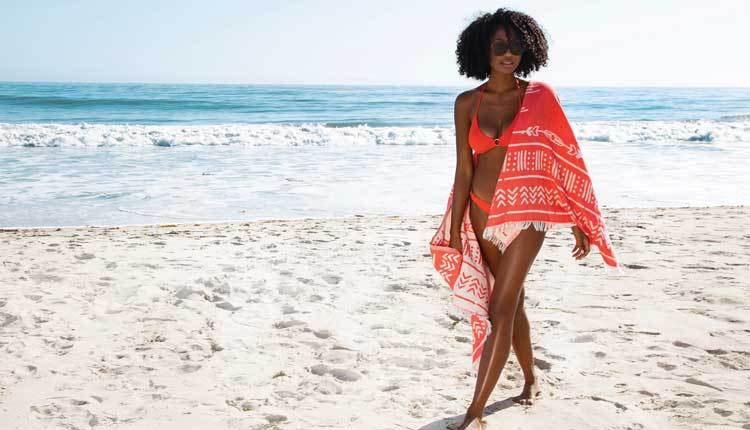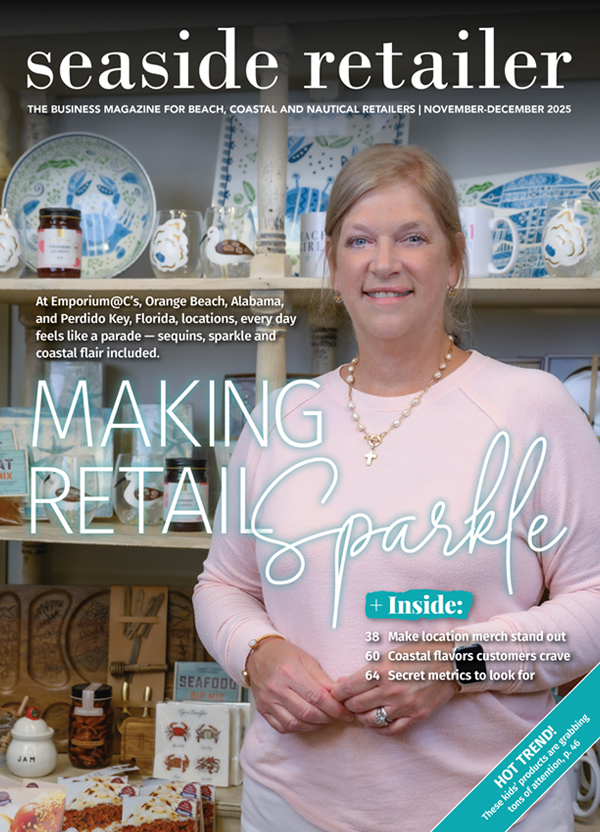Towels are a basic necessity for any beachgoer, but the towels available to your customers today can be described as anything but basic. Style options, special features, fabric type, print, color and size are just some of the options customers consider when they are on the hunt for that perfect beach towel to purchase for their next beach outing.
Customer preferences vary, and what they seek in a towel is no different. Some may be looking for a low price point, while others are looking for luxury. Still others might prefer Turkish over terry or cotton over rayon. No matter what your customer is seeking, you can provide options to fit just about any preference.
Breaking with tradition
The heatwave that hit much of the country during the summer of 2022 had beach visitors seeking natural fibers and goods made of cotton, bamboo and rayon, according to Marcel Schneider of product distributor A to Z Towels.
Mary Watters, owner of Charleston, South Carolina-based wholesaler and retailer, Beachables, agrees, “100% cotton is an all around winner. Sustainability, natural fiber and durability are all key.”
According to Shannon DiPadova, co-founder of Riviera Towel Co., the trend is to move beyond a traditional terry cloth towel toward towels that are multipurpose. “That’s why Turkish towels are so popular,” she says. “They can be used as not only a towel, but also can be used as a sarong or wrap. They are also great for travel.”
Lou Donovan, owner of towel brand Louka Gold says she is selling more of her luxury range of beach and pool towels as of late. “People are looking for quality and are willing to spend a little more for a towel that will last upwards of five years.”
Turkish cotton reins supreme in Donovan’s experience. “It remains the most popular choice for beach towels, and this is due to the natural qualities of Turkish cotton being highly absorbent, fast drying and sand resistant — perfect for the beach.”
Angele Mitchell, founder of Turkish towel company Wonderfouta, agrees, “Cotton is king, but textured towels are in strong demand as opposed to the regular flatwoven.”
Wonderfouta carries a Lions foot towel and a Oudja weave that are more intricate and heavier than flatwoven towels “and that is the appetite that will definitely carry in 2023,” she says. “Thicker, richer and fuller in body than just stripes.”
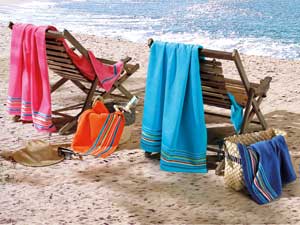
Vibrant colors, patterns or stripes like these from A to Z Towels are hot trends.
Polyester is a hot seller for wholesaler Mutual Sales due to its sand-repellent qualities, says Samantha Walker, sales manager, but she adds, the company still sells a large amount of cotton and velour.
Tommy Bahama beach towels are constructed in soft cotton terry velour which is highly absorbent, low linting and fade resistant, according to the company.
“They are printed in a reactive dye that keeps colors vivid even after repeated washings and sun exposure — they are also easy care and machine washable, which means you can use them every day,” Chrisann Furciato, senior vice president of licensing, says.
High-performance fabrics like microfiber are also growing in popularity, notes Jan Soolman, owner of Clutch Towels. “They are super absorbent, quick drying and very compact,” she says. “It just makes life easier.”
But she adds, “Performance is only half of it. Beach towels should be stylish and fun!”
Beyond boring
Soolman hand selects each color and creates all the bright and happy designs featured on her towels. Each towel includes an elastic band which inspired the brand name.
“The bright colors and fun designs are really eye-catching in stores, and my unique elastic band keeps the towels neatly folded together, making them super compact and space-saving, which is great when store space is at such a premium,” she says.
“No one wants a boring beach towel,” Watters says, echoing the trend. “Woven patterns, embellished and interesting colors are definitely the favorites.”
Another attribute to Watters’ Beachables that make them anything but ordinary are their uses. They also double as a large beach bag and chair cover. “No more boring beach bag and separate towel that just won’t stay put on your chair,” she says. “The Beachable will consolidate all your beach-day necessities, transform into your full-sized Turkish towel and fit over the back of your chair where it will stay put throughout the day.”
The Sol Wrap from Salt N Rays offers UPF 50 sun protection, another fabric category that is growing with more awareness of sun cancer risks. As the name indicates, it is not only a towel but can be worn as a wrap, protecting the skin from the sun’s harsh rays.
“UPF items for seaside retailers are essential,” says owner Christy LaSalle, who in addition to selling her products wholesale, also owns a brick-and-mortar store in Shelton, Connecticut. “They also want sand-free and compact options because this is what their customers are looking for as well.”
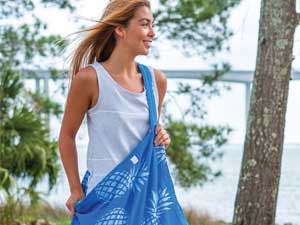
Towels that serve multiple purposes like Beachables are hot trends.
In her store, customers spend time picking out patterns for each person they are buying for. “The more options, the better,” she advises. “The cute prints make it easy to buy for multiple people. Everyone wants their own.”
Though styles and prints can vary by geographic location, Schneider says blues, oranges, teals and turquoise are always the most popular solid towel colors. He adds, “Basic stripes and stripe combinations are always in high demand.”
Popular prints include flowers, hibiscus, tropical landscapes and animated or graphic animals such as flamingos, sharks and turtles.
Alex Harvey, licensing and marketing director for Guy Harvey says tropical prints and all-over geometric prints are trending. The brand’s most popular print is the Americana Sailfish followed by the Porpoise Group.
Large motifs of florals, vibrant colors, and mix and match prints with solids or stripes are among Tommy Bahamas biggest trends. Designs that mimic beach elements and movements are also big sellers such as watercolor and painterly applications featuring fluid and washy strokes for the movement of the water. The designs “inspire people to think of their next summer getaway,” says Furciato.
Walker has noticed a surge in souvenir/name-dropped towels. “Consumers have been gravitating toward souvenir towels with the name of the destination they are visiting. They also make great gifts,” she says.
Sustainable threads
Beyond the designs, consumers are going deeper than ever before into the ethical practices of the brands they are purchasing, and towels are no exception. Not to worry. Plenty of towel brands are embracing the sustainability movement.
“No one wants a boring beach towel. Woven patterns, embellished and interesting colors are definitely the favorites.” – Mary Watters, Beachables
The fabric used in Nomadix towels are made from certified post-consumer recycled plastic. “Our fabric is quick drying and made of sustainable materials, which buyers seek out,” says Elena Qualls, Nomadix director of sales. The company is also part of 1% for the Planet, an organizations whose members donate at least 1% of annual sales to support environmental causes, and it is carbon-neutral certified.
Clutch Towels are also made from 50% recycled water bottles. Clutch Towels, Tommy Bahama, Louka Gold and Riviera Towel Co. towels are all Oeko-Tex 100 Certified meaning every aspect of the product is free of harmful substances.
“They have been tested for 100 harmful chemicals and substances and declared free of these, therefore making them not only safe for your skin but also for the planet,” says Donovan of the 100% natural Turkish cotton used in Louka Gold’s products.
Getting their attention
Carrying soft, beautiful, versatile towels for your customers is only half the story of managing a successful towel section of your store. Merchandising is the other 50%. And towel wholesalers have plenty of advice for moving towels.
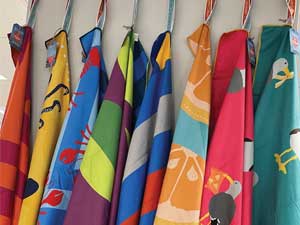
Customers like the fun patters and display options that Clutch Towels products allow.
“Retailers tend to display towels folded. That works great for solids and stripes and when the client is already looking to buy a towel, but customers also have a tendency to buy when they see the full designs,” says Schneider. “By showing the full towel, retailers can get customers’ attention even if they weren’t initially planning to look at towels.”
He also suggests variety. “Having many designs available increases the chances of a sale. I always tell my clients having six pieces of 10 styles is better than 20 pieces of three designs.”
And lastly, he says to customize. “Clients are more inclined to buy a towel with customization, embroidered or printed. This provides the experience and the perfect souvenir.”
“Towels are best displayed hanging so consumers can see the whole design,” agrees Walker. “Hanging them in windows helps pique interest from consumers walking by.”
Qualls recommends keeping a variety of prints in stock and educating staff on their features and benefits, while Watters advises retailers to display their towels and Beachables “in a way that will make the customer feel that they are just steps from the beach.”
Riviera Towel Co. packages its towels in wrap bands for easy stacking and displays, but DiPavoda says, “We encourage retailers to take some out of the wrap bands and hang them up so customers can see the different designs and feel the soft fabric.”
According to Mitchell, “Variety is really what gets towels sold.”
Harvey recommends displaying the towels in an area that shows off the artwork and allows the customer to feel the material, “which is one of the bestselling features of our towels.”
And don’t forget to engage the customer. “Everyone could use a great towel for the summer, but many still don’t know that there are [other] options than a traditional, big bulky terrycloth towel, so tell them,” says Soolman.
“Create a display with the bright colors, let them feel the unique fabric and display a sign shouting out the unique features. Sales are sure to follow.”
